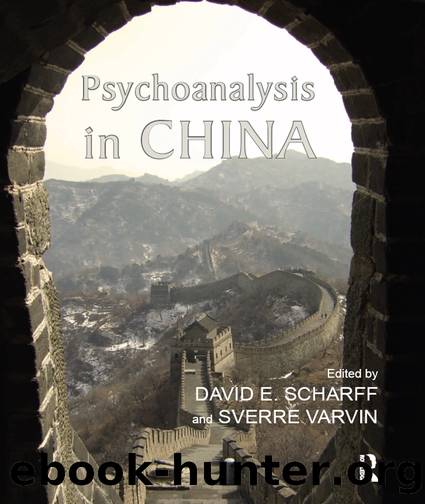PSYCHOANALYSIS IN CHINA by David E. Scharff and Sverre Varvin

Author:David E. Scharff and Sverre Varvin
Language: eng
Format: epub
Publisher: Routledge
CHAPTER FOURTEEN
The development of psychoanalysis in China
Shi Qijia
Introduction
Even in the Warring States Period of 400 BC, China had a rudimentary form of psychotherapy described in the classical works of The Yellow Emperor’s Canon of Medicine. Later, drawing on Confucianism, Taoism, and Buddhism, based on the concepts of yin and yang, the theory of five elements, and the interdependence of microscopic and macroscopic worlds, China produced traditional medicine to understand mind and spirit. In the nineteenth century, following the introduction of western medicine and psychiatry, China developed a new understanding of the human body, spiritual activities, and mental illness. Then in the early twentieth century, psychoanalytic theory, coming to China at first indirectly through Japan, had a great effect on Chinese philosophy, psychology, social ideology, literature, and the relationship between science and art, even before it promoted the development of Chinese psychiatry and psychotherapy. The May Fourth Movement of the 1920s and 1930s formed a prelude for new ideas and developing social relations. At this stage, Freud’s psychoanalytic theories began to be translated, starting with the Study of Dreams by Zhixiu Qian in 1914. The famous philosopher Dongsun Zhang wrote The Discussion of Psychoanalysis (The Bell of People) in 1920, and The Psychoanalytic ABC in 1929. Tianxiu Yu, founder of the Chinese Sociological Association, stressed the importance of psychoanalysis in The History of Medicine and Psychology in an article about Freud’s theory.
Gao Juefu, China’s most famous modern psychologist, first translated and introduced Freud to China systematically. He emphasised Freud’s ideas concerning sexual repression, the unconscious, and the death instinct. He both praised and criticised Freud, holding that we needed to have a critical attitude in studying him. His writings quickly spread on college campuses and set off an upsurge of interest in Freud.
Others appreciated the potential of psychoanalysis for treatment. The scholar Shizhao Zhang, who read Totem and Taboo in 1921 and translated Freud’s autobiography, may have been the only Chinese who had direct contact with Freud. The letter to Shizhao from Freud follows:
Dear Professor,
I am very pleased with your intention. You can put it into practice in any way, either can explore psychoanalytic knowledge in your motherland—China—or you can write articles for our Imago magazine. In these articles, you can compare in your language what we guess about the ancient forms of expression of mental illness. China’s part in my lecture was taken from the Encyclopedia Britannica (11th edition).
Sincerely,
Freud
In this period, other scholars, such as Jinsheng Zhang, Jingxi Wang, and Dengbo Wang, introduced sexual instinct theory, the theory of the unconscious, and other psychoanalytic doctrine. Ever since the May Fourth Movement, the marriage between literature, literary criticism, and psychoanalytic theory were essentially synchronous. In fact, literature was perhaps the most active catalyst promoting the spread of psychoanalysis to a wide audience in China, reaching a climax in the 1930s, when Bingham Dai applied psychoanalysis to mental disease. Dai may be the first Chinese who applied psychoanalysis in the realm of medical science, and he is probably the inaugurator of Chinese psychiatry.
Download
This site does not store any files on its server. We only index and link to content provided by other sites. Please contact the content providers to delete copyright contents if any and email us, we'll remove relevant links or contents immediately.
Understanding Sleep and Dreaming by William H. Moorcroft(746)
Doing Psychotherapy by Robin Shapiro(746)
Cognitive Behavioural Therapy For Dummies by Rob Willson & Rob Willson(666)
104 Activities That Build: Self-Esteem, Teamwork, Communication, Anger Management, Self-Discovery, Coping Skills by Alanna Jones(655)
True Refuge: Finding Peace and Freedom in Your Own Awakened Heart by Tara Brach(644)
Archetypal Patterns in Fairy Tales by Marie-Louise von Franz(592)
An Introductory Dictionary of Lacanian Psychoanalysis by Evans Dylan(591)
The Light That Failed by Stephen Holmes(584)
The Light that Failed by Ivan Krastev(583)
P by Unknown(577)
A Primer for Beginning Psychotherapy by William N. Goldstein(564)
Change by Kottler Jeffrey A(562)
Raising Self-Esteem in Adults by Susan Buchalter(533)
Self-Therapy, Vol. 3: A Step-by-Step Guide to Using IFS for Eating Issues, Procrastination, the Inner Critic, Depression, Perfectionism, Anger, Communication, and More (Self-Therapy Series) by Jay Earley(532)
Change Your Thinking [Third Edition] by Sarah Edelman(532)
2 by Slings & Arrows(523)
Handbook of Adolescent Behavioral Problems by Thomas P. Gullotta Robert W. Plant & Melanie A. Evans(500)
Zen and Psychotherapy by Joseph Bobrow(497)
10 Steps to Mastering Stress by Barlow David H. Rapee Ronald M. Perini Sarah(488)
